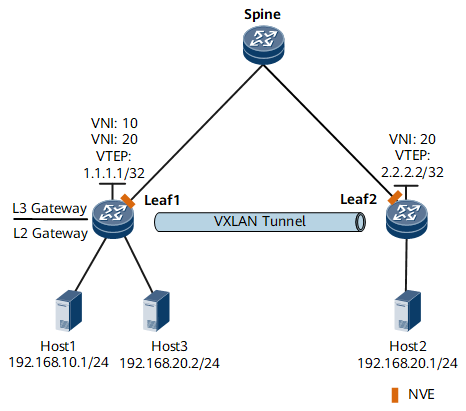VXLAN Scenario
A VXLAN tunnel is identified by a pair of VTEP IP addresses. During VXLAN tunnel establishment, the local and remote VTEPs attempt to obtain IP addresses of each other. A VXLAN tunnel can be established if the IP addresses obtained are routable at Layer 3. When BGP EVPN is used to dynamically establish a VXLAN tunnel, the local and remote VTEPs first establish a BGP EVPN peer relationship and then exchange BGP EVPN routes to transmit VNIs and VTEP IP addresses.
In distributed VXLAN gateway scenarios, leaf nodes function as both Layer 2 and Layer 3 VXLAN gateways. Spine nodes are unaware of the VXLAN tunnels and only forward VXLAN packets between different leaf nodes. On the control plane, a VXLAN tunnel only needs to be set up between leaf nodes. In Figure 1, a VXLAN tunnel is established between Leaf1 and Leaf2 for Host1 and Host2 or Host3 and Host2 to communicate. Because Host1 and Host3 both connect to Leaf1, they can directly communicate through Leaf1 instead of over a VXLAN tunnel.

A VXLAN tunnel is determined by a pair of VTEP IP addresses. When a local VTEP receives the same remote VTEP IP address repeatedly, only one VXLAN tunnel can be established, but packets are encapsulated with different VNIs before being forwarded through the tunnel.

- When Host3 communicates with Host2 and Leaf1 functions as a Layer 2 gateway (that is, in a VXLAN Layer 2 forwarding scenario), by default, the packets passing through Leaf1 (Host3's original packets encapsulated with VXLAN headers) are hashed based on the VNI and MAC addresses (source and destination MAC addresses of Host3). To implement a hash calculation based only on the VNI, perform global configuration on Leaf1 connected to the VXLAN tunnel.
- When Host1 communicates with Host2 and Leaf1 functions as a Layer 3 gateway (that is, in a VXLAN Layer 3 forwarding scenario), by default, the packets passing through Leaf1 (Host1's original packets encapsulated with VXLAN headers) are hashed based on the VNI and IP addresses (source and destination IP addresses of Host1). To implement a hash calculation based only on the VNI, perform global configuration on Leaf1 connected to the VXLAN tunnel.